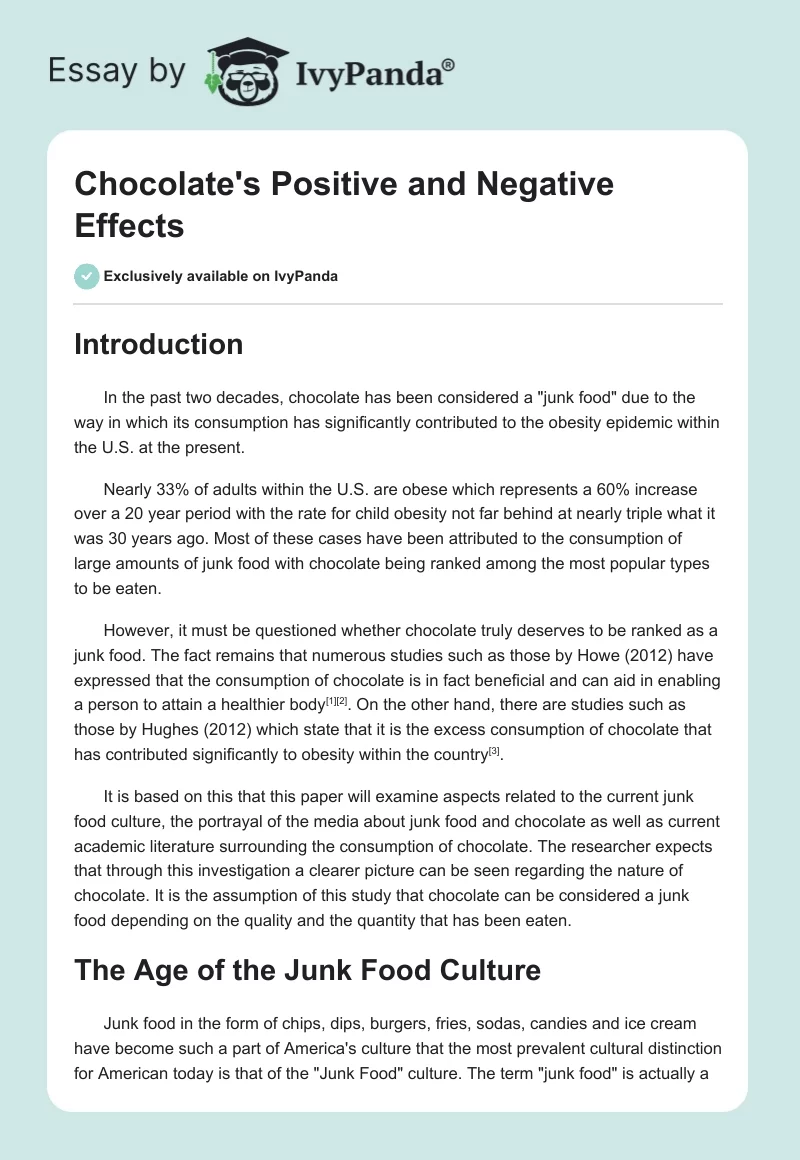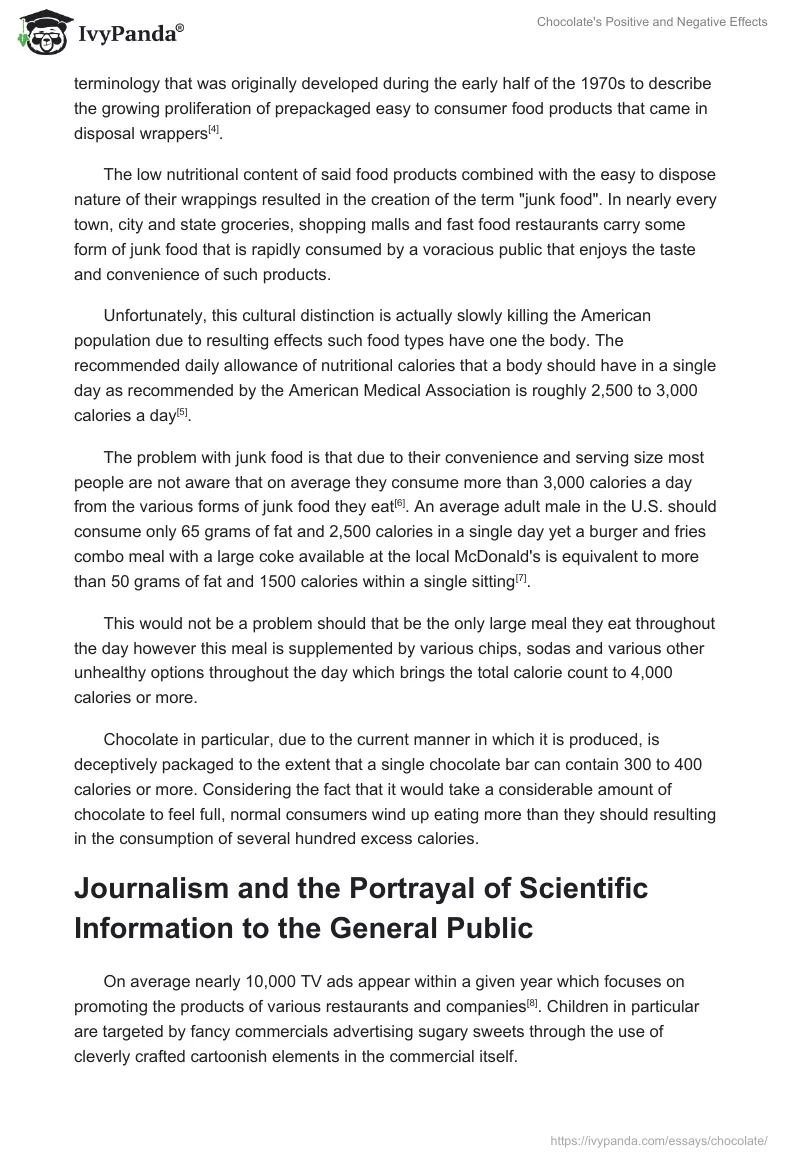Introduction
In the past two decades, chocolate has been considered a “junk food” due to the way in which its consumption has significantly contributed to the obesity epidemic within the U.S. at the present. Nearly 33% of adults within the U.S. are obese which represents a 60% increase over a 20 year period with the rate for child obesity not far behind at nearly triple what it was 30 years ago. Most of these cases have been attributed to the consumption of large amounts of junk food with chocolate being ranked among the most popular types to be eaten.
However, it must be questioned whether chocolate truly deserves to be ranked as a junk food. The fact remains that numerous studies such as those by Howe (2012) have expressed that the consumption of chocolate is in fact beneficial and can aid in enabling a person to attain a healthier body. On the other hand, there are studies such as those by Hughes (2012) which state that it is the excess consumption of chocolate that has contributed significantly to obesity within the country.
It is based on this that this paper will examine aspects related to the current junk food culture, the portrayal of the media about junk food and chocolate as well as current academic literature surrounding the consumption of chocolate. The researcher expects that through this investigation a clearer picture can be seen regarding the nature of chocolate. It is the assumption of this study that chocolate can be considered a junk food depending on the quality and the quantity that has been eaten.
The Age of the Junk Food Culture
Junk food in the form of chips, dips, burgers, fries, sodas, candies and ice cream have become such a part of America’s culture that the most prevalent cultural distinction for American today is that of the “Junk Food” culture. The term “junk food” is actually a terminology that was originally developed during the early half of the 1970s to describe the growing proliferation of prepackaged easy to consumer food products that came in disposal wrappers.
The low nutritional content of said food products combined with the easy to dispose nature of their wrappings resulted in the creation of the term “junk food”. In nearly every town, city and state groceries, shopping malls and fast food restaurants carry some form of junk food that is rapidly consumed by a voracious public that enjoys the taste and convenience of such products.
Unfortunately, this cultural distinction is actually slowly killing the American population due to resulting effects such food types have one the body. The recommended daily allowance of nutritional calories that a body should have in a single day as recommended by the American Medical Association is roughly 2,500 to 3,000 calories a day.
The problem with junk food is that due to their convenience and serving size most people are not aware that on average they consume more than 3,000 calories a day from the various forms of junk food they eat. An average adult male in the U.S. should consume only 65 grams of fat and 2,500 calories in a single day yet a burger and fries combo meal with a large coke available at the local McDonald’s is equivalent to more than 50 grams of fat and 1500 calories within a single sitting.
This would not be a problem should that be the only large meal they eat throughout the day however this meal is supplemented by various chips, sodas and various other unhealthy options throughout the day which brings the total calorie count to 4,000 calories or more.
Chocolate in particular, due to the current manner in which it is produced, is deceptively packaged to the extent that a single chocolate bar can contain 300 to 400 calories or more. Considering the fact that it would take a considerable amount of chocolate to feel full, normal consumers wind up eating more than they should resulting in the consumption of several hundred excess calories.
Journalism and the Portrayal of Scientific Information to the General Public
On average nearly 10,000 TV ads appear within a given year which focuses on promoting the products of various restaurants and companies. Children in particular are targeted by fancy commercials advertising sugary sweets through the use of cleverly crafted cartoonish elements in the commercial itself.
Since TV advertisements are an extension of popular culture it can be seen that popular culture is one of the primary reasons behind the obesity problem America now faces due to this patronage of products that are not only unhealthy but cause people to become obese as a result of their consumption. The power of advertising should not be underestimated since it has been shown that TV ads are one of the best ways to convince people to buy a certain product.
From this it can be seen that the causes behind obesity is not merely the fast food culture that Americans find themselves in but also the actions of various corporations that promote with wild abandon their products without taking into consideration the possible ramification on the population. It should be noted though that along with these numerous advertisements come equally numerous articles by journalists which deride and criticize food companies for ruining the health of the present day generation.
However, what is lacking in such articles is a truly in-depth examination of the nutritional impact of individual junk food products. What occurs is merely a general critic instead of an examination which attempts to determine whether foods such as chocolate have any generally positive effects.
Positive Effects of Chocolate
While it may be true that chocolate has become a synonymous aspect of the junk food culture, the fact remains that it has a variety of positive healthy effects on the body.
This encompasses effects related to better cardiovascular health, an increased metabolism, and brain stimulation. Not only that, chocolate has also been stated as being a possible anti-depressant as well as possessing anti-cancer and anti-oxidant effects. However, its relation as a junk food has been cemented due to the manner in which it is consumed in amounts that are greater than the recommended dietary allowance per day.
As it was revealed in the study of Howe (2012), chocolate and its numerous iterations has been mixed and matched with a plethora of substances to the point that its health benefits have been highly diluted through an assortment of brands and products. Its health benefits are tempered by extreme amounts of added sugar along with prodigious amounts of carbohydrates and assortment of chemicals.
The end result is a product that combines the positive mental stimulation of cocoa with the negative impact of a high fructose corn syrup. It is based on this that it can be stated that any health benefits derived from chocolate depends on the type of chocolate and the amount that is consumed. Thus chocolate can be considered a health food so long as one eats it sparingly and consumes chocolate products that are rich in natural cocoa and have little sugar in them.
Conclusion
Based on the information and arguments that has been provided in this paper thus far, it can be stated that can be considered a junk food depending on the quality and the quantity that has been eaten.
Reference List
Benton, David. 2004. Coffee, Tea, Chocolate and the Brain. Florida: CRC Press Datar, Ashlesha, and Nancy Nicosia. 2012. “Junk Food in Schools and Childhood Obesity.” Journal Of Policy Analysis & Management 31, no. 2: 312-337.
Howe, James. 2012. “Chocolate and Cardiovascular Health.” Gastronomica 12, no. 1: 43-52.
Hughes, Linda G. 2012. “More chocolate? Yes, please: Obesity epidemic threatens to erode heart disease progress.” Indianapolis Business Journal 10. Regional Business News, EBSCOhost .
Hurley, JayneLiebman, Bonnie. 2008. “Choosing Chocolate.” Nutrition Action Health Letter 35, no. 8: 12.
Pollan, Michael. 2008. In defense of food: An eater’s manifesto. New York: Penguin
Robinson, Elizabeth. 2008. “Become a Media Megastar: Analyzing junk food advertising.” Screen Education no. 49: 82-87.


